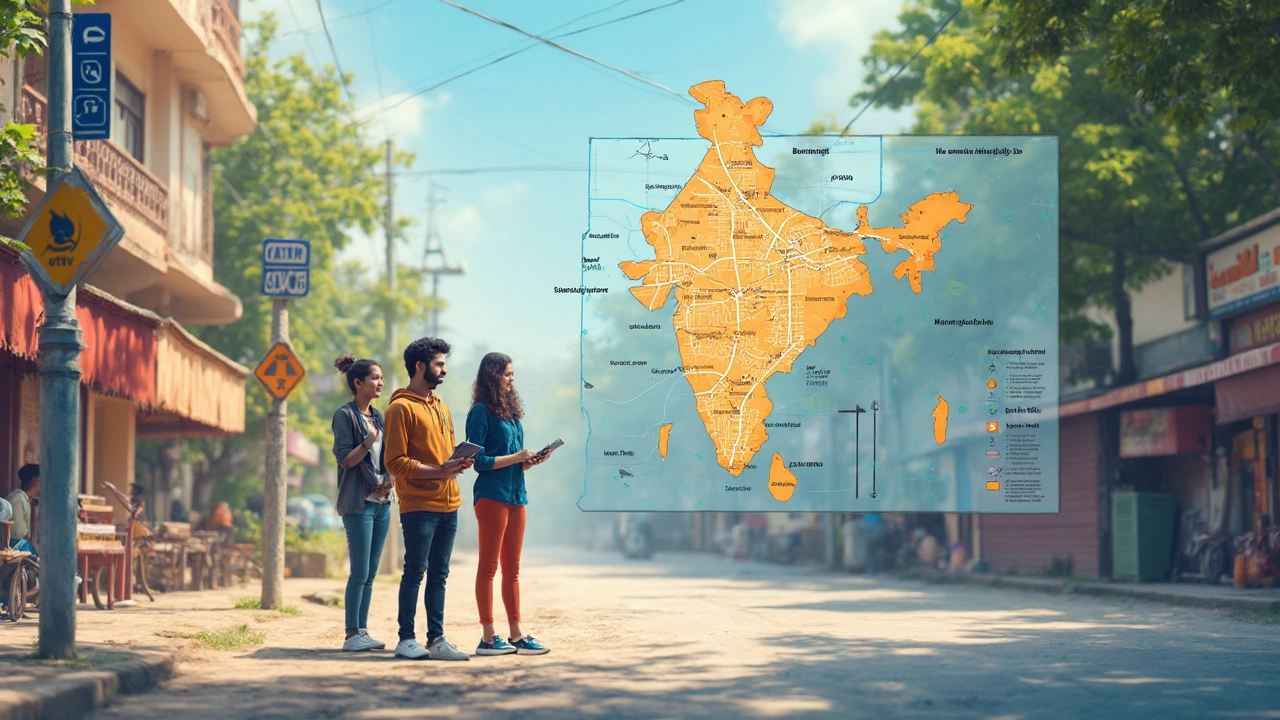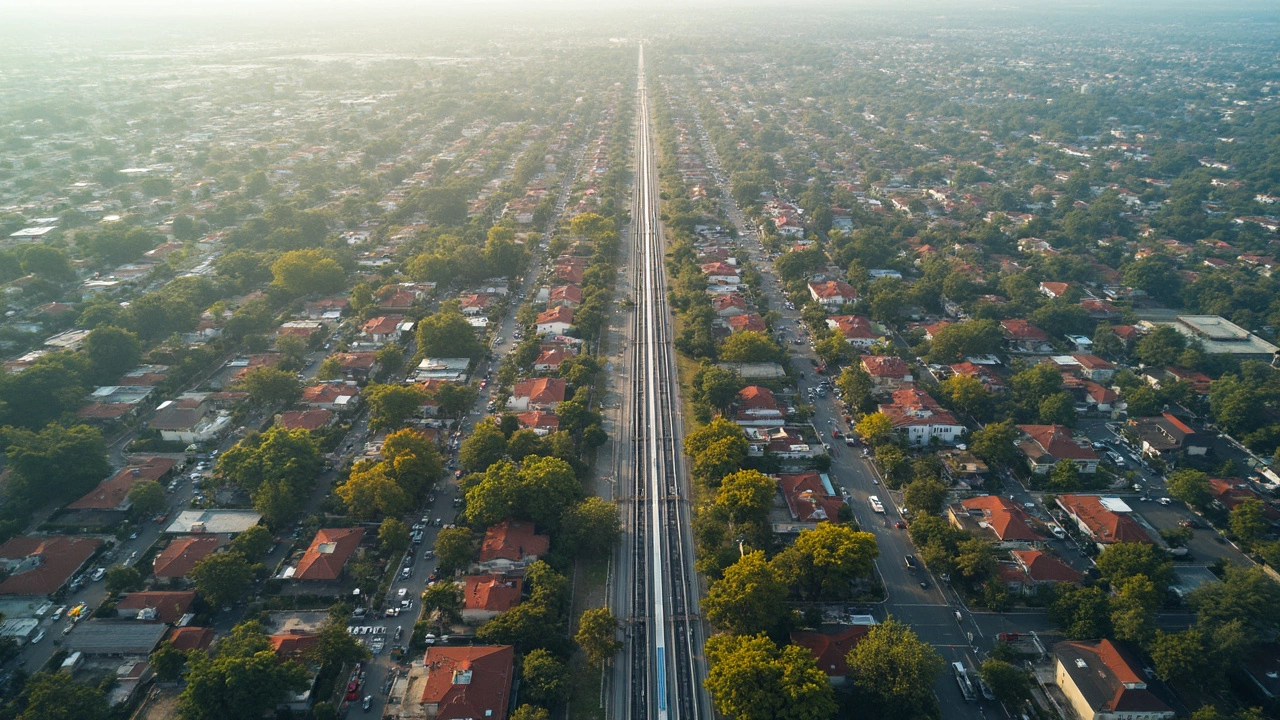Metro Area Defined: What Counts as Living Near the Metro?

Think being 'near the metro' means having a train stop right outside your door? Not always. The idea of a 'metro area' is actually pretty loose, depending on who you ask. For buyers and renters, understanding this can make a real difference—what starts off sounding convenient might end up meaning an extra 30-minute drive, thanks to how these areas are drawn up.
If you're house hunting or browsing rentals, cities and real estate sites throw around 'metro area' a lot, but almost nobody agrees on a single definition. The term can mean just the downtown core, the sprawling suburbs, or even neighboring small towns, depending on how city planners, census bureaus, and property agents set the lines. If you're banking on city life or quick commutes, knowing exactly what 'metro area' covers could save you a bunch of time and money. So let’s break down how these boundaries are made—and why it matters a lot more than you think when you’re searching for that perfect spot.
- What Does 'Metro Area' Mean?
- Who Decides the Boundaries?
- How Boundaries Impact Property Value
- Commuting: The Real Test of 'Near the Metro'
- Tips for Finding the Best Metro-Accessible Properties
What Does 'Metro Area' Mean?
When you hear 'metro area,' you might picture city skyscrapers or crowded subway stations, but the official meaning is a lot broader. It actually refers to the bigger region built around a main city, including suburbs and any towns or neighborhoods that connect to that central spot for jobs, shopping, or schooling. If you see 'property near metro' in listings, they're usually talking about homes in this zone—not just places a block away from the train.
The folks at the U.S. Census Bureau have a detailed definition. They call these places Metropolitan Statistical Areas (MSAs). To count as an MSA, an area needs at least one city of 50,000 people or more, plus a bunch of nearby communities with strong ties to that city. These ties can be economic, like lots of people commuting into the city for work. These zones often stretch way past what you’d consider "downtown"—think of all the surrounding suburbs, big shopping malls, and sometimes even farmland just on the edge.
Take Dallas, for example. Its official "metro area" includes not just Dallas itself but also Fort Worth, Arlington, Plano, and a bunch of other cities, thanks to how many people live, work, and travel across the region. The map below gives you an idea just how much ground a metro area can cover:
| Metro Area | Main City | Nearby Cities Included | Population (2023 estimate) |
|---|---|---|---|
| Dallas-Fort Worth-Arlington | Dallas | Fort Worth, Arlington, Plano, Irving | 7,943,685 |
| New York-Newark-Jersey City | New York City | Newark, Jersey City, Yonkers | 19,617,869 |
| Los Angeles-Long Beach-Anaheim | Los Angeles | Long Beach, Anaheim, Santa Ana | 12,872,800 |
If you're wondering why it matters, think about commutes, local taxes, and even school options—living in an official metro area could mean way more choices or a different pace of life than you might expect just from the city name alone. Always double-check which cities and neighborhoods are actually in the metro area before making a property decision.
Who Decides the Boundaries?
So who actually decides where a metro area starts and ends? You’d think there’d be some concrete rule, but there isn’t just one group in charge. In the United States, the main player is the Office of Management and Budget (OMB). Every decade, they update what they officially call “Metropolitan Statistical Areas” or MSAs, using data from the Census. Their criteria look at population numbers, density, and how much people travel back and forth to the core cities for work. Funny enough, these maps sometimes skip over neighborhoods folks would swear are part of the city, just because they don’t meet technical requirements.
But that’s not the whole story. State and city governments also draw their own lines for metro area boundaries. Zoning maps, tax regions, and public transportation plans will use their own definitions depending on the purpose. Even real estate sites throw in their two cents, choosing to highlight properties as 'near the metro’ if it helps get attention, sometimes stretching the term a bit.
Here's a breakdown of who really calls the shots:
- OMB and the U.S. Census Bureau: Set the official MSAs based on hard stats.
- Local Governments: Change boundary lines for planning, schools, taxes, and public services.
- Transit Authorities: Decide what’s served by city buses, subways, and train lines—sometimes drawing much wider areas.
- Realtors & Property Websites: Sometimes stretch or shrink boundaries to help market a home or apartment as a ‘property near metro’ hot spot.
Here’s something interesting—some metro areas cross multiple states or cover dozens of separate towns, all lumped together because people commute to the same economic heart. For example, the Dallas-Fort Worth metro area covers 11 counties. That’s why one property might be a 10-minute drive from downtown while another 'metro' property could be more than an hour away.
So don’t just trust the label—always double-check local transit maps or city planning documents before deciding a property is truly in the heart of the metro area.

How Boundaries Impact Property Value
Where a property sits inside—or just outside—the metro area line can change its value more than you might think. Buyers want convenience, and many are happy to pay a premium for a spot that's officially considered part of the metro area. That’s because stuff like public transit, schools, shopping, and jobs are usually a lot more accessible the closer you are to the real 'metro' core.
Here's the thing: if your place is just inside the metro boundary, you’ll probably find higher home prices, sometimes by tens of thousands of dollars, compared to a similar home just a few blocks farther out. One study from Zillow a couple years back showed suburban properties within walking distance to metro stops in big cities (like Washington, D.C. and Atlanta) sold between 10% and 20% higher than similar homes farther from the stations. This gap can get even wider in cities where traffic is a nightmare and public transport is a huge selling point.
Local taxes also play a big role. Properties inside the city boundaries—which usually make up the heart of the metro area—often face higher taxes, but they get services like faster emergency response, priority on snow plows, and better utility upkeep. Sometimes being outside those boundaries means missing out on perks, which can drag down the value, even if places look pretty much the same from the street.
If schools are a big deal for you, those invisible boundary lines matter there, too. Metro areas often have better-resourced schools—think newer buildings, more extracurriculars, and higher ratings. Homes zoned for these schools can carry a steeper price tag, all because of where they're drawn on the map.
| Location | Average Home Price | Metro Status |
|---|---|---|
| Downtown (within metro) | $560,000 | Metro core |
| Suburb, near metro stop | $490,000 | Metro fringe |
| Suburb, outside boundary | $410,000 | Non-metro |
So if you're looking at property near metro and see a price jump just for being 'officially' inside a line, you’re seeing the boundary effect in action. Always check local zoning maps and ask for breakdowns of nearby amenities and real commute times before you settle on a place. The true value of a map line? Sometimes, it's the difference between a morning subway ride or a frustrating highway grind every day.
Commuting: The Real Test of 'Near the Metro'
“Close to the metro area” might show up in listings, but the real test is how you actually get around. It’s not just about the birds-eye distance—it’s about the time and hassle it takes to get from your house to the nearest train, bus, or main road. Sometimes a place is just two miles from a station, but if you’re stuck crossing highways or waiting on a slow local bus, that 'nearby' spot can turn into a total headache.
Here’s a wild fact: in cities like Washington, D.C. and Los Angeles, studies have shown that actual commuting times can double just by being a few extra blocks away from a direct metro line—seriously, a half-mile difference can add up to 15 or even 30 minutes each way. That’s a big deal if you’re doing it five days a week.
| Distance From Metro Stop | Average Commute Time (One Way) |
|---|---|
| 0.2 miles | 17 mins |
| 1 mile | 28 mins |
| 2 miles | 39 mins |
What should you really look for if you want solid metro access? Don’t just check the map—try the routes yourself during rush hour. If you’re using real estate apps, use their transit filters, but double-check with Google Maps or local transit apps for actual travel times from the exact address you’re looking at. Ask neighbors or people already living there about their daily routine. Sometimes the only available station has a packed parking lot by 7 a.m., or the last train leaves earlier than you’d expect. These little details matter way more than just seeing a metro logo on a map.
- Walk the route from your potential address to the metro area. See how safe and quick it really is.
- Check if there are sidewalks, street lights, and crosswalks—sounds basic but can make a huge difference in winter or late evenings.
- Consider options for biking or e-scootering if you’re not right next to a station.
- See what public transit looks like outside of rush hour, not just in the mornings—weekends, late nights, and holidays can be totally different stories.
The closer you are to reliable, walkable, and fast transit, the more you’ll get out of living in a metro area. Don’t just trust the listing—make the trip yourself and see if the reality matches the sales pitch.

Tips for Finding the Best Metro-Accessible Properties
If you’re looking for property near metro lines or smack dab in the metro area, you want more than just a map pin. Here’s how you can really figure out what counts as convenient, and what’s just a long walk with groceries.
- Use official transport maps: Head right to your city’s public transit website. Most of them have interactive tools where you can see not just line routes, but all major bus and connecting rail stops. You can filter property searches by distance to stations—go for something within half a mile for really easy access.
- Test out the commute: Google Maps offers up-to-date transit info, including walking times, transfer points, and even how often trains run. Plug in your possible new address to see what your real door-to-door commute looks like during rush hour. Some cities, like Washington D.C. and New York, have apps that let you track in real time how reliable the metro is for your neighborhood.
- Look for walkability scores: Walk Score is a trusted site where you just type in the address and get a number showing how easy it is to get around without a car. A score of 70 or above usually means you’ve hit a pretty walkable area.
- Talk to locals: Online forums, neighborhood Facebook groups, or even a quick chat at a nearby coffee shop will clue you in about delays, last-mile connections, or construction affecting metro access. Sometimes, what looks good on paper has a catch in real life.
- Compare costs and benefits: Properties closest to a metro area stop might have higher prices, but if you factor in what you’ll save on gas, parking, or car ownership, living near reliable transit could come out ahead. See the example below for how these costs can stack up.
| Scenario | Monthly Transit Cost | Monthly Parking/Gas Cost |
|---|---|---|
| Metro-accessible property | $110 (transit pass) | $50 (occasional rideshare) |
| Car-dependent suburb | $0 | $240 (gas & parking) |
A property directly on a metro area line isn’t always the perfect fit for everyone, but you can tip the odds in your favor by using real commute data, checking local resources, and thinking through the real costs. If you go beyond agent buzzwords and do your own digging, you’ll end up with a spot that’s truly connected and makes everyday life much easier.









Write a comment